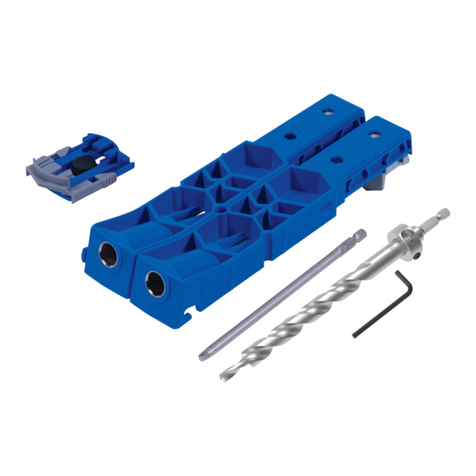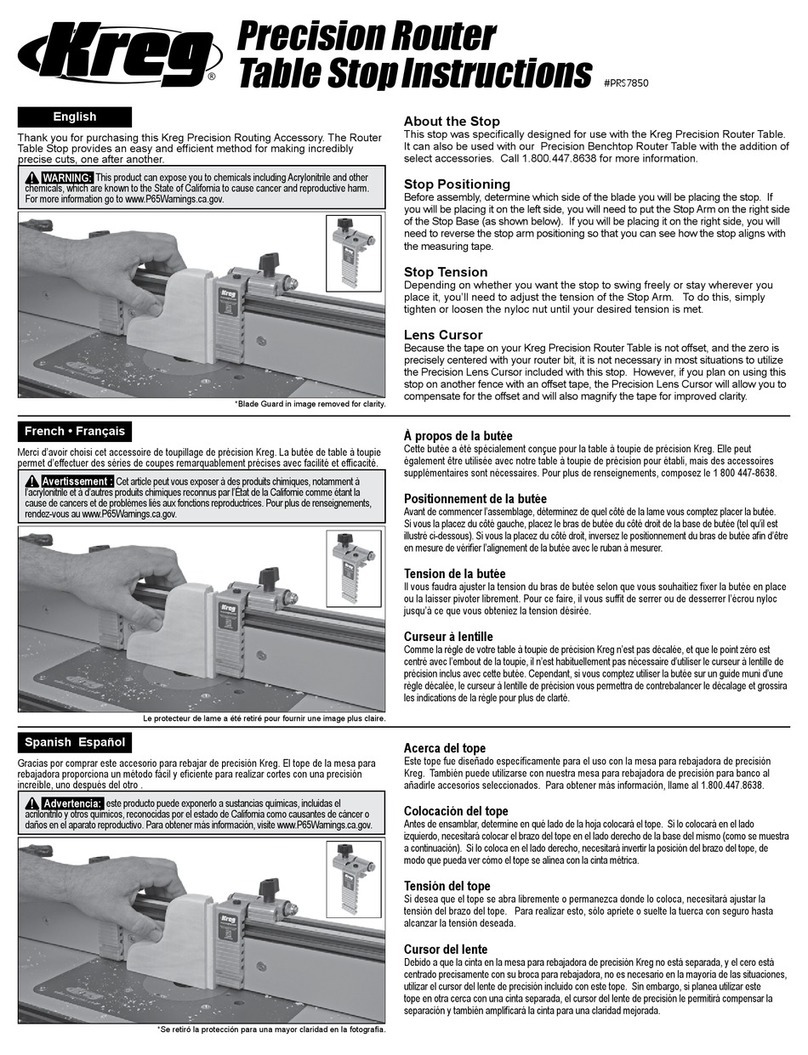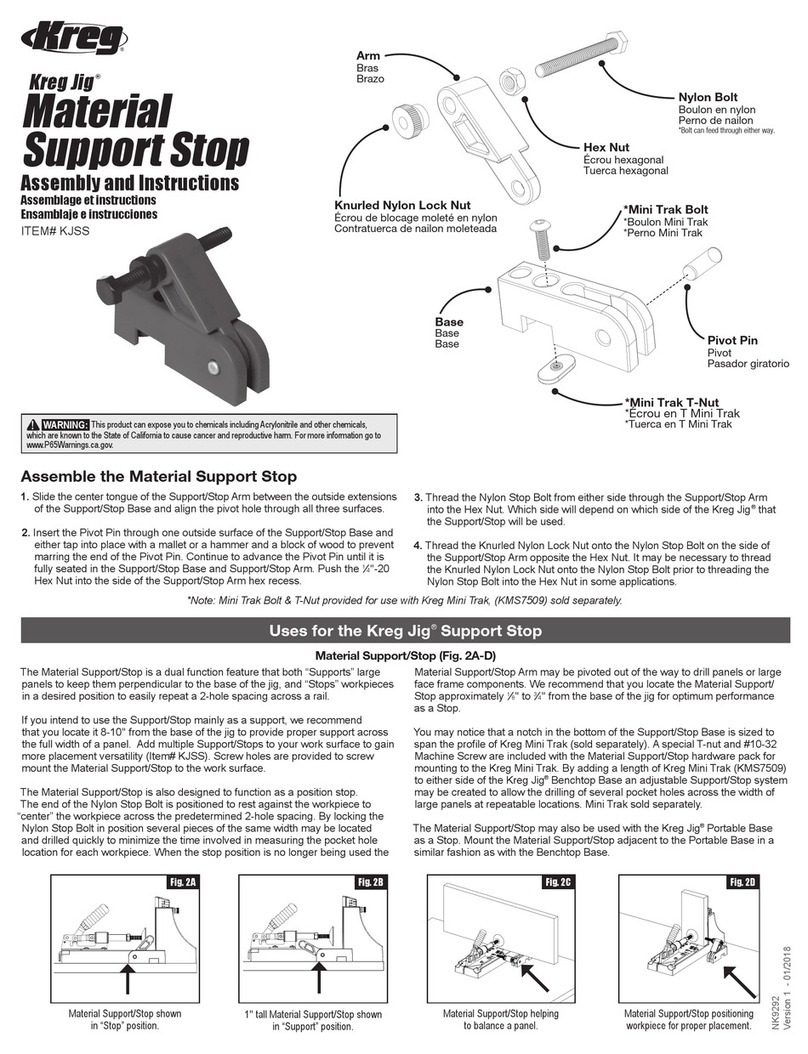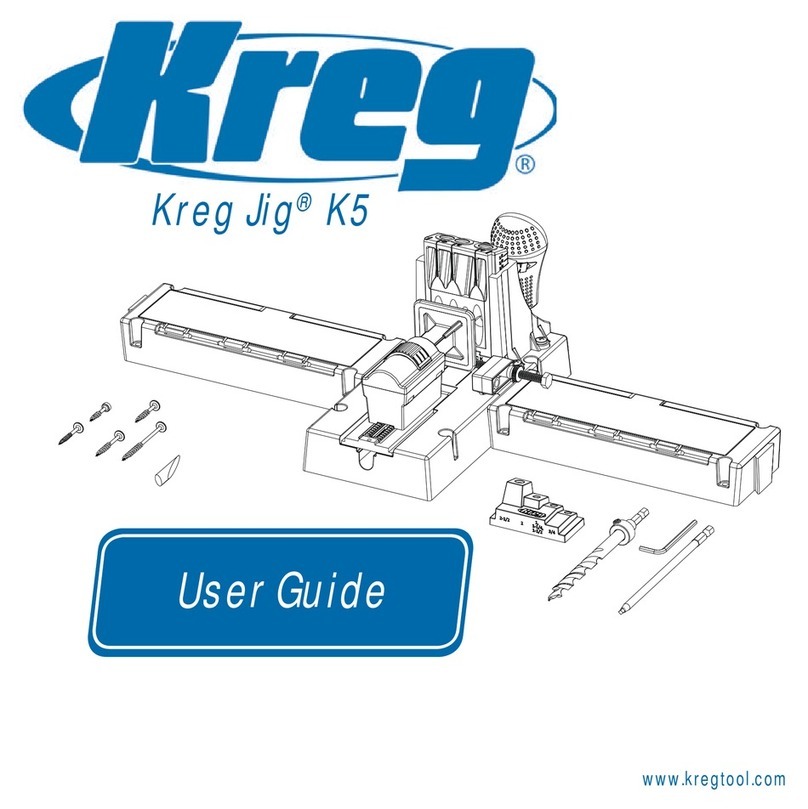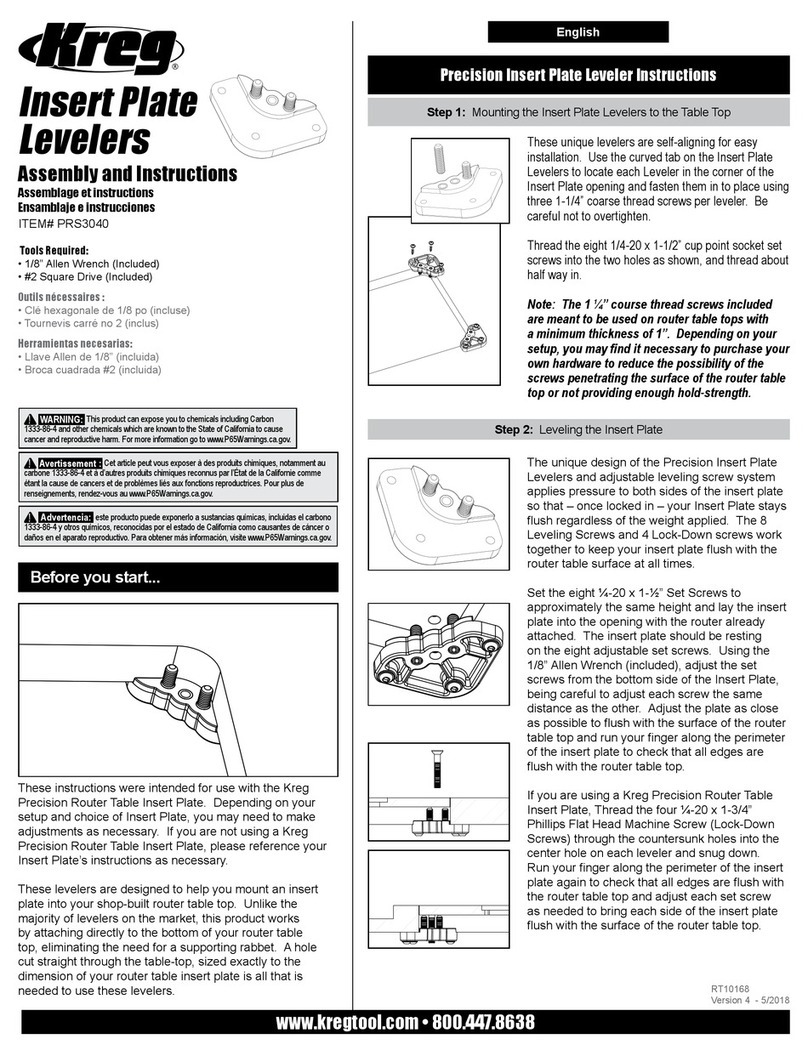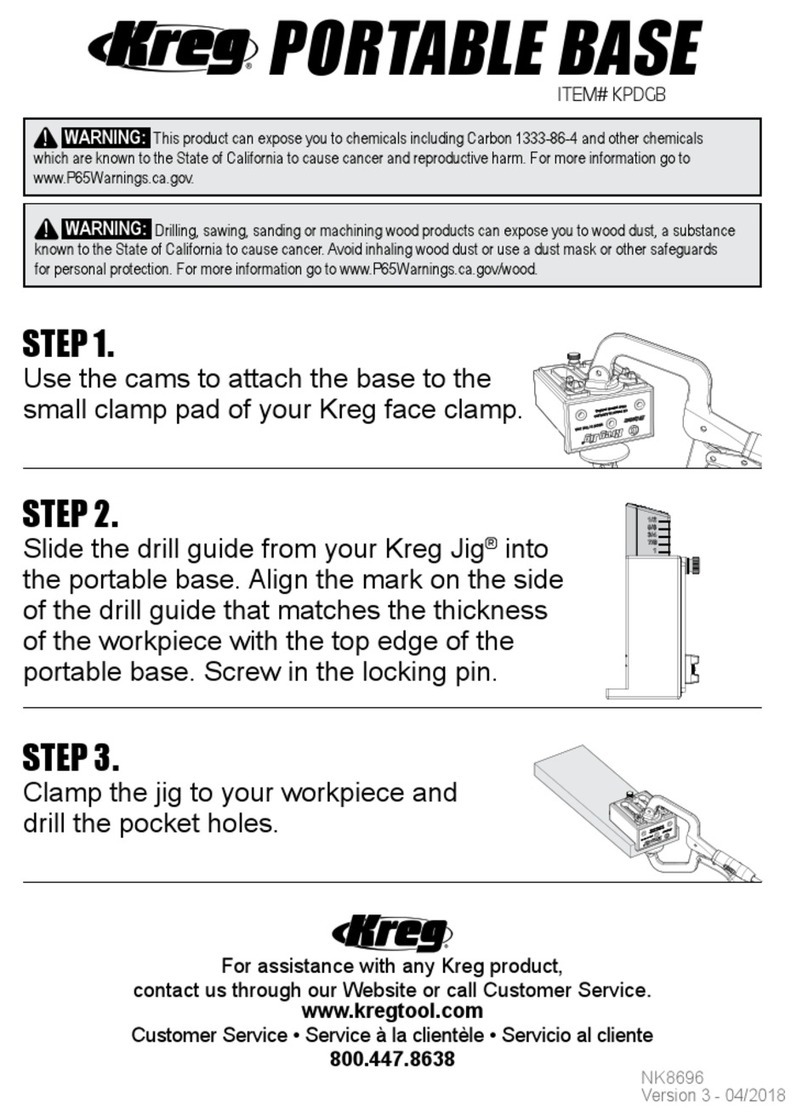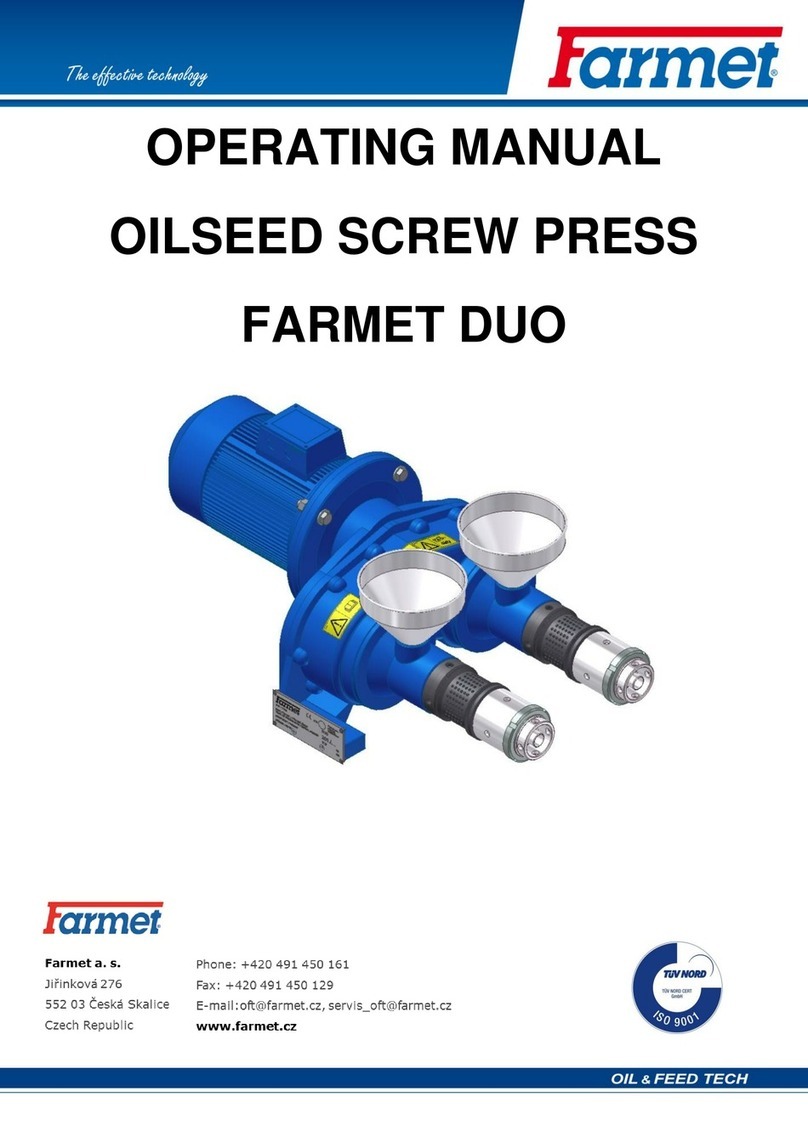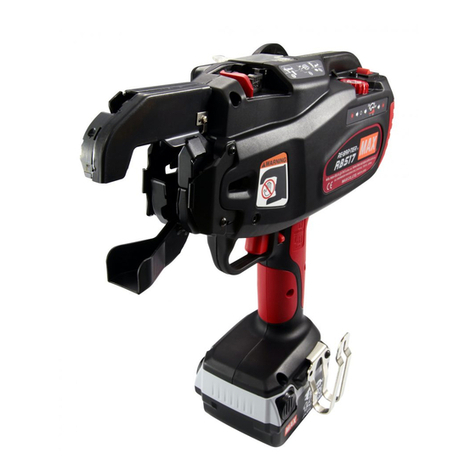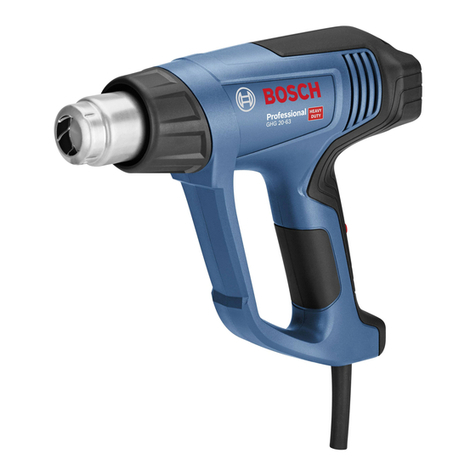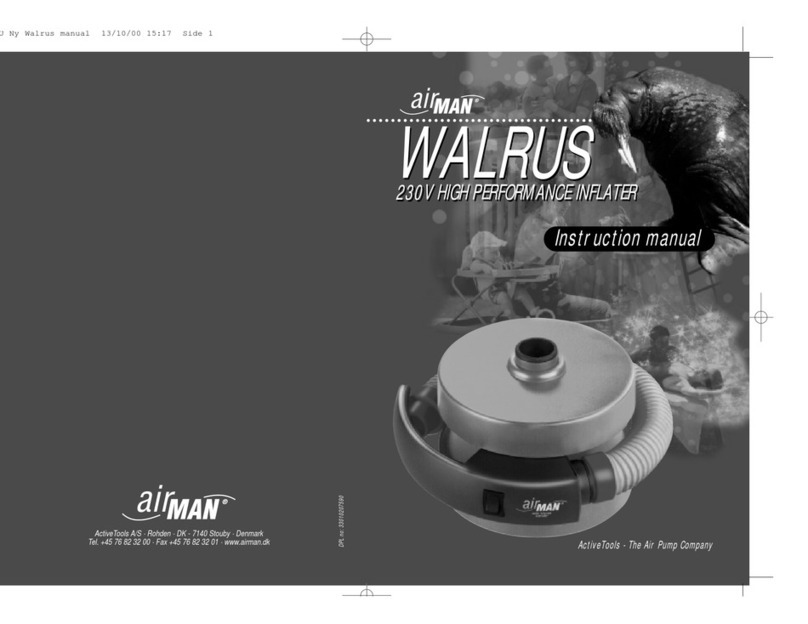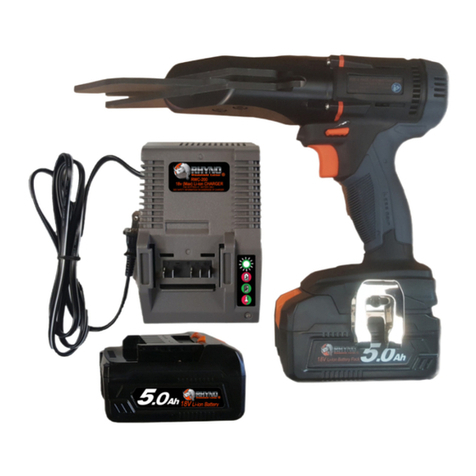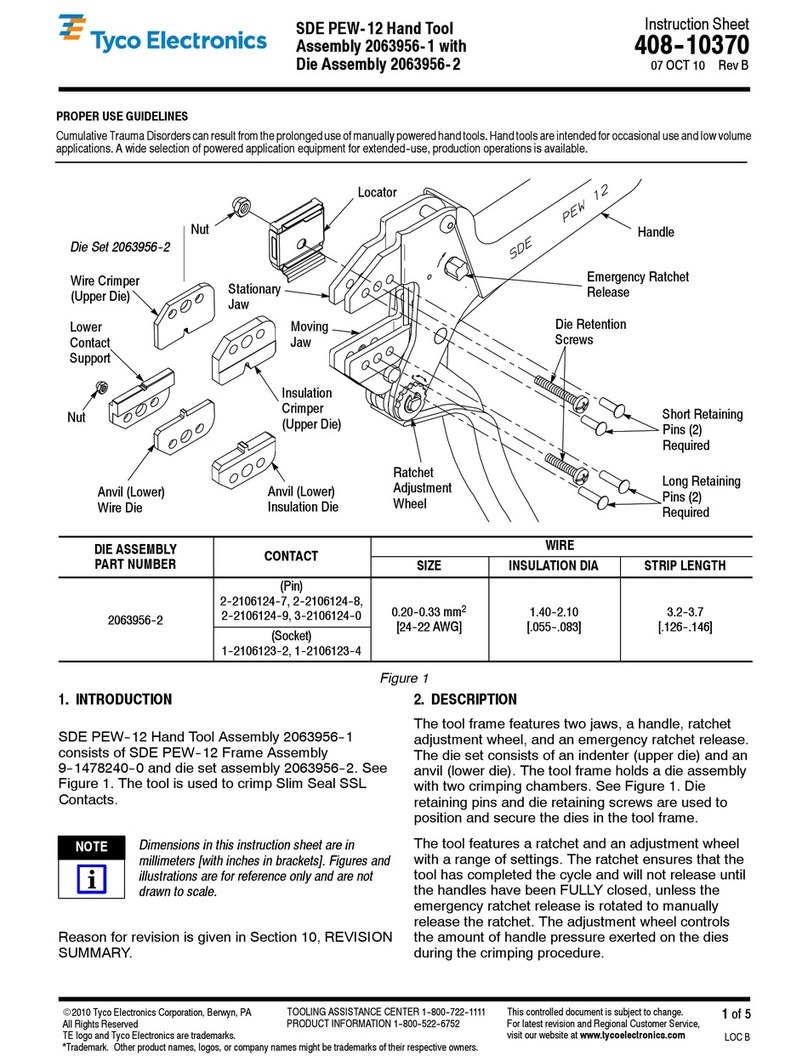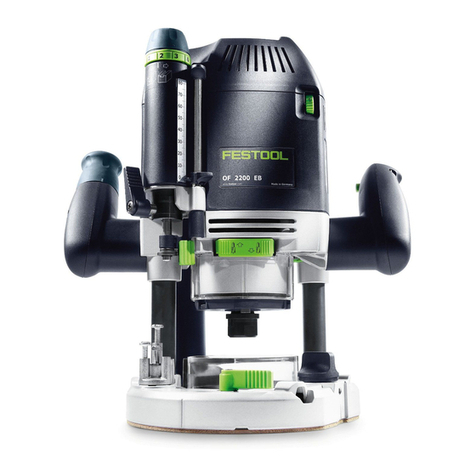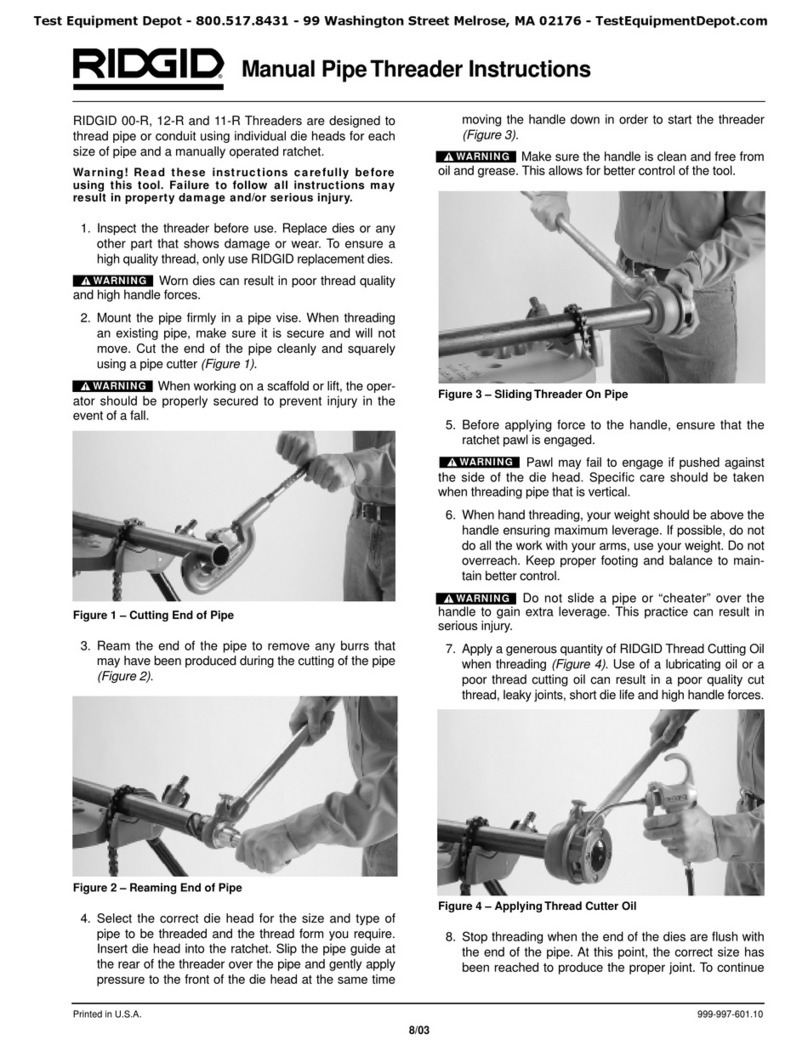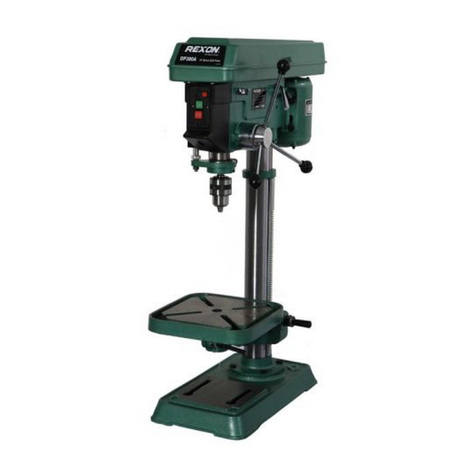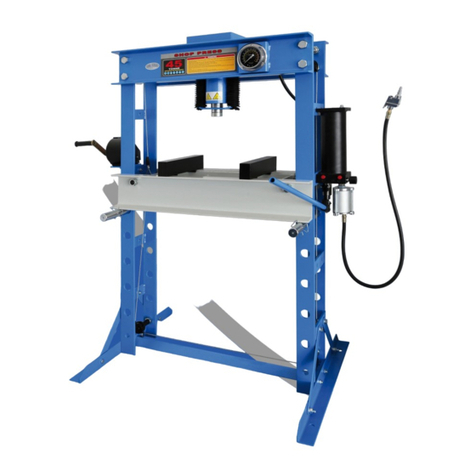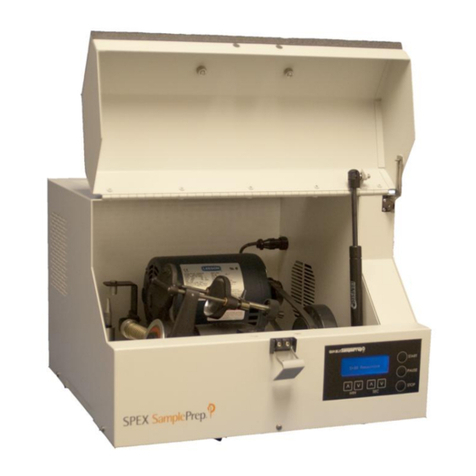Kreg Jig K5 User manual

Kreg Jig®K5 / Kreg Jig®K5 Master System
NK8816
Version2- 11/2016
Owner’s Manual
Manuel de l'utilisateur
Benutzerhandbuch
Manual del usuario
Manuale dell'utente
Handleiding voor de eigenaar

Safety Guidelines
!
!
Read this manual and these safety guidelines. Learn the applications and limitations of the tool
as well as the hazards specic to it. Operating the tool before understanding safe and proper use
could result in personal injury. SAVE THIS MANUAL.
• Always wear eye, hearing, and respiratory protection specically designed and certied as safety
equipment.
• The drill bit is sharp. Handle with care.
• Avoid awkward hand positions where a sudden slip could cause contact with the rotating bit.
• Properly secure your workpiece before drilling. When using the drill guide independently of the
jig base, do not attempt to hold the drill guide in place by hand. Always use a clamp.
• Follow your drill manufacturer’s safety guidelines.
• Do not operate this tool or any machinery while under the inuence of drugs, alcohol, or
medications.
• Do not allow familiarity gained from frequent use of your tools to replace safe work practices. A
moment of carelessness is sufcient to cause severe injury.
WARNING This product contains one or more chemicals known to the State of California to
cause cancer and birth defects or other reproductive harm. Wash hands after handling.
WARNING Dust created by sanding, sawing, grinding, drilling, and other construction
activities may contain chemicals known to the State of California to cause cancer and birth
defects or other reproductive harm. Examples of these chemicals are:
•Lead from lead-based paints
•Crystalline silica from bricks, cement, and other masonry products
•Arsenic and chromium from chemically treated lumber
Your risk from exposure to these chemicals depends on how often you do this type of work.
To reduce your exposure, work in a well-ventilated area with approved safety equipment.
Owning a Kreg Jig® opens up new project possibilities. This manual shows you how to adjust your
jig and drill pocket holes. You may nd the following resources helpful:
Kreg Tool Online
kregtool.eu. Find it all here: product information, videos, tips, project plans, and more.
Kreg Owner’s Community
kregjig.ning.com. Join thousands of enthusiastic Kreg owners who swap tips and advice, share
their projects, and more.
Kreg Newsletters: Sign up for our free email newsletters at kregtool.eu.
• Kreg Plus: Your source for handy woodworking and DIY tips and tricks, project ideas, and much more.
• Kreg Tool News: Stay up to date on the latest Kreg tools and learn about special offers.
• Kreg Community News: Learn about projects being built in the Kreg Owner’s Community, and
get free plans.
Introduction
1

Parts
Additional Master System Parts
Your Kreg Jig® K5 or K5 Master System is almost ready to use right out of the box. Apply the
screw-length selection guide label to the inside of one extension lid. Place the jig on your
workbench and t the dovetail keys on the extensions into the dovetail slots in the base. The jig
and extensions feature holes for mounting to a board.
A
B
C
D
E
F
G
H
I
J
K
L
M
N
O
P
Q
R
S
T
U
V
W
X
Y
S
2

K5 and K5 Master System Parts
Base
Features four holes for securing the jig to a workbench or auxiliary base
Drill-guide socket
Accepts all Kreg drill guides: Micro, Standard (included), and HD
Toggle handle
Operates workpiece clamping mechanism
Clamp assembly
Powerful internal spring applies clamping pressure
Ratchet plate
Provides clamp-assembly adjustment
Ratchet release
Disengages clamp assembly from ratchet plate
Standard drill guide
Features marks for positioning the guide for different workpiece thicknesses
Locking pin
Spring-loaded pin locks the drill guide into the drill-guide socket at the selected setting
Step bit
Simultaneously drills a pilot hole and clearance hole, forming a bearing shoulder for
the screw head
Stop collar
Controls drilling depth
Hex wrench
For the stop-collar set screw
Stop-collar setting block
Ensures proper positioning of the depth collar on the drill bit
Driver bit
#2 square-drive bit 6" (152mm) long
Workpiece stop
Stop snaps into keyhole slots in the base
Workpiecestopne-adjustmentnut
¼-20nuttsintohexrecessinworkpiecestop
Knurled nut
Nylonknurlednutactsasjamnuttoxthepositionofthene-adjustmentscrew
Fine-adjustmentscrew
¼-20x2½"(64mm)nylonboltthreadsintonuttoprovideno-slipneadjustment
Parts
A
B
C
D
E
F
G
H
I
J
K
L
M
N
O
P
Q
3

K5 and K5 Master System Parts
Vacuum port
Acceptsa1¼"(32mm)shopvacuumhoseforefcientchipremoval,swivelssidetoside
Extension Wings
Provide support for wide workpieces and storage for bits and accessories
Screw-length selection guide
Apply this self-adhesive label to the inside of an extension lid for easy reference
Spacer block
In repair applications, positions the drill guide for drilling pocket holes in
¾" (19 mm)-thick material
Pocket-screw sample pack
Contains10eachofthevemostoftenusedscrews
Pocket-hole plug sample pack
Containsvepaint-gradewoodplugs
Additional Master System Parts
The K5 Master System includes the following parts
Portable base
Accepts Micro, Standard, and HD drill guide blocks. Useful for large panels or
assembliesthatwouldbedifculttoclampintoabench-mountedjig.Built-incams
secure the portable base to your Kreg clamp.
3" WoodProjectClampwithAutomaxx®
Provides fast and secure clamping when assembling a pocket-screwed joint. Set
the desired pressure and this 3"-reach clamp automatically adjusts to any
material thickness up to 3" (76mm).
Parts
R
S
T
U
V
W
X
Y
Tocreatestrongjoints,you’llsetyourjigtomatchthe
thickness of the workpiece and the length of the screw.
The Kreg Jig®makesthiseasy,injustfoursimplesteps:
Using the Kreg Jig®K5 and K5 Master System
4

Using the Kreg Jig®K5 and K5 Master System
Set the Drill Guide
For a strong joint, the screw should exit close to the center of
the workpiece. To adjust the pocket-hole position, retract the
spring-loaded drill-guide locking pin (H). Then raise or lower
the drill guide (G) until the mark on the side of the guide that
matches the thickness of the workpiece is even with the top
oftheguidesocket(B).Releasethelockingpin.
1
G
B
H
Fine Thread
Because the smaller diameter and thread
pitch of our #7 ne-thread screws reduce
the chance of splitting the material, we
recommend them for hardwoods.
Use in woods such as:
• Ash • Oak • Maple • Walnut • Hickory
• Cherry • Mahogany • Birch
2
All Kreg pocket screws feature a deep square drive that improves driver engagement and reduces the
possibility of cam-out. The self-tapping auger point eliminates the need to drill a pilot hole.
Coarse Thread
Due to the large diameter and thread pitch,
our #8 coarse-thread screws offer a strong
hold in softwoods and composite materials.
Use in woods such as:
• Pine • Cedar • Basswood • Poplar
• Plywood • Melamine • Particle Board
Screw Selection / Kreg Jig
®
Setting Chart
Material Thickness Screw Length Kreg Jig®Setting
1⁄2" [13 mm]* 1" [25 mm]†
3⁄4" [19 mm]††
1⁄2" Mark
5⁄8" [16 mm] 1" [25 mm] 5⁄8" Mark
3⁄4" [19 mm] 11⁄4" [32 mm] 3⁄4" Mark
7⁄8" [22 mm] 11⁄2" [38 mm] 7⁄8" Mark
1" [25 mm] 11⁄2" [38 mm] 1" Mark
11⁄8" [29 mm] 11⁄2" [38 mm] 11⁄8" Mark
11⁄4" [32 mm] 2" [51 mm] 11⁄4" Mark
13⁄8" [35 mm] 2" [51 mm] 13⁄8" Mark
11⁄2" [38 mm] 21⁄2" [64 mm] 11⁄2" Mark
Kreg offers a complete line of pocket screws for every workpiece thickness and type. Use this chart to select the
correct screw length.
Choose a Screw
Your KREGprojects demand KREG Screws. Learn why at kregtool.com/kregscrews
5
Note: Screw length is
measured from bottom
of the head to the tip of the screw.
11⁄4" [32mm]
†For standard Drill Guide
††For optional Micro Drill Guide only
*Panhead pocket screw
recommended.

Using the Kreg Jig®K5 and K5 Master System
Position the Stop Collar
Place the stop-collar setting block (L) on the jig base in
front of the drill guide. Slide the step bit (I) into one of the
drill guide bushings and drop the pilot tip into the hole in the
block that corresponds to the length of the screw you’ll be
using. With the step bit shoulder resting on the block, slide
the stop collar (J) onto the drive-end of the bit so it rests on
the drill guide. Tighten the stop collar set screw with the hex
wrench (K).
Use the chart below as a guide for positioning the drill-bit
stop collar when using the standard drill guide and bit as
well as the optional Micro Pocket Drill Guide and bit and
Kreg Jig®HD drill guide and bit. Always make a test joint
withstockthesamethicknessasyournishedworkpieces
before proceeding with your project.
3
K
J
I
L
Example: 3⁄4" (19mm) board, 11⁄4" (32mm) screw
Drill Guide & Bit Material Thickness Screw Length Setting Block Step
Micro* ½" (13mm) ¾"** ¾"
Micro* & Standard 1⁄2"-1⅛"(13mm-29mm) 1", 1¼", 1½" 1", 1¼", 1½"
Standard 1¼"-1⅜"(32mm-35mm) 2" 2"
Standard & HD* 1½" (38mm) 2½" 2½"
**Use a panhead pocket screw.
Adjust the Clamp Assembly
Press down on the ratchet release (F) and slide the clamp
assembly (D) all the way back. Position the workpiece
against the drill guide. Move the toggle handle (C) to the
full-down (clamped) position. Slide the clamp assembly
forward until the pad contacts the workpiece. (You’ll hear
the adjustment mechanism clicking.)
4
C
F
D
Using the Stop-Collar Setting Block
*optional accessories
Holding the clamp assembly against the workpiece, raise
the toggle handle until you hear the adjustment mechanism
click two times. Move the toggle handle to the clamped
position. Check to make sure the workpiece is securely
held in place. If needed, raise the toggle handle one more
click. The clamp assembly is now positioned so the internal
springappliessufcientpressuretosecuretheworkpiece
when the toggle handle is in the full-down position.
6

Features
Vacuum Port
Thischip-collectionattachment(R)snapsintoplaceon
the back of the drill guide socket. The port accepts any
standard 1¼" (32mm) vacuum hose and conveniently
swivels from side to side. In addition to helping keep your
workareaclean,efcientchipremovalspeedsdrillingtime
and reduces heat build-up, extending the life of your drill bit.
R
Q
NP
Kreg Jig®K5 Master System Additional Features
Workpiece Stop
For repetitive pocket-hole drilling operations, the stop (N)
snaps into keyhole slots in the base. To install, drop the
pegs on the bottom of the stop into the large end of the
keyhole slots and slide the stop toward the front of the jig.
For precise pocket-hole placement, press the steel nut (O)
into one of the hexagonal recesses in the stop. Thread
the knurled nut (P) onto the nylon bolt (Q) and thread the
bolt into the nut from the opposite side of the stop. The nut
and bolt work together to provide easy adjustment and the
knurled nut locks the bolt in position.
3" Wood Project Clamp with Automaxx®
These 3" (76mm)-reach clamps automatically adjust
to workpiece thickness up to 3" (76mm). To keep joints
perfectly aligned when driving pocket screws, clamp the
workpiecestoaatsurface,centeringtheclamppadover
the joint line. Adjust the clamp to apply enough pressure to
keeptheworkpiecesushandstablebutnotsotightthat
clampingandunclampingaredifcult.
Portable Base
Use this base for large panels or assemblies that would
bedifculttoclampintoabench-mountedjig.Remove
the drill guide from the drill-guide socket and slide it
into the portable base. Align the mark on the side of the
drill guide that matches the thickness of the workpiece
with the top edge of the portable base. Screw in the
locking pin. The base also accepts Micro and HD drill
guideblocks.Built-incamssecuretheportablebaseto
a Kreg clamp.
7

Pocket-Hole Placement
In addition to the proper Kreg Jig®settings, spacing pocket holes evenly across the workpiece is an
important part of getting a strong joint. The Kreg Jig®features a three-hole drill guide that allows you
do this in a variety of workpiece widths without the need to reposition the workpiece after drilling each
hole. Use the guide below to determine how to position your workpiece for drilling pocket holes.
Beforeturningonthedrill,slidethebitintothedrillguideuntilthetipofthebittouchesthe
workpiece. Withdraw the bit about ¼" (6mm). Turn on the drill, make sure it is running at
full speed, and feed the bit into the workpiece. Always run variable-speed or multi-speed
drills at the fastest speed. A shop vacuum connected to the vacuum port quickly removes
the wood chips and the hole can be drilled in one motion. When not using a shop vacuum,
remove the vacuum port, and while drilling the pocket hole, partially withdraw the bit
several times to clear the chips. Stop drilling when the stop collar contacts the drill guide.
Wait until the drill stops rotating to withdraw the bit from the drill guide.
Forwidepartssuchaspanels,werecommendplacingtherstpockethole2"(51mm)fromthepanel
edge and every 6" (152mm) to 8" (203mm) on center after that. When drilling panels, you can use any
drill guide hole.
Drilling Pocket Holes
Withthepocketholesdrilled,positionandclampyourparts.Smallatassembliescanbe
alignedbyclampingthemtoaatsurface.WhenusingaKregclamptoclamplargeat
assemblies off the edge of your work surface, position the large clamp pad on the side of
the joint opposite the pocket holes. Align the corners of case assemblies, such as a cabinet
or bookshelf, using bar clamps or a Kreg right-angle clamp. (See Optional Accessories.)
With your assembly securely clamped, drive the pocket screws using a variable-speed
drill/driver and the included 6" (152mm) driver bit. For drills with a clutch, adjust it to fully
seat the screws without over-driving them.
Joining parts
1" to 2" Wide Material 2" to 3" Wide Material 3" to 4" Wide Material
Use B and C guides Use A and B guides Use A and C guides
(25mm to 51mm Wide Material) (51mm to 76mm Wide Material) (76mm to 102mm Wide Material)
8

Repair Applications
For ½" (13mm)-thick material, align the bottom of the drill
guide with the edge or end of the part to be drilled. For thicker
stock, attach one or more spacer blocks (U) to the drill guide.
Each spacer block accommodates an additional ¼" (6mm)
in material thickness. For example, ¾" (19mm)-thick material
requires one spacer block, 1" (25mm)-thick material requires
two blocks, and 1¼" (32mm)-thick material requires three
blocks. One spacer block is included with your Kreg Jig®.
Additional blocks are available.
For repair applications, remove the drill guide from the drill
guide socket and clamp it directly to the workpiece.
U
When using the drill guide separately in a repair application,
remembertosetthestopcollar,andrmlysecurethedrill
guide to the workpiece with a Kreg clamp. In situations where
using a clamp is not possible, you may screw the drill guide
directly to the workpiece, as shown.
9
Adjusting Clamp Pressure
To increase clamp pressure, turn
the knurled-head screw to the
left (viewed from the handle-end
of the clamp); for less pressure,
turn the screw to the right.
Less
Pressure
More
Pressure

Tips
For boards at least 3" (76mm) wide, pocket holes
drilledwiththe“A”and“C”guidesbothtentirelyon
the face of the board. In this situation, simply position
the mitered workpiece on the jig, clamp it in place,
and drill.
Mitered Corners
To position a pocket screw close to the miter “toe” on a wide
workpiece or to position a second pocket screw on a narrow
workpiece and still have the hole entirely on the face of the
part, drill the pocket hole closest to the miter heel with the drill
guideinthedrillguidesocket.Removetheguidefromthe
socket. For ¾" (19mm)-thick stock, attach a spacer block (U)
to the drill guide. Position the drill guide with the spacer-block
end 1½" (38mm) from the miter toe, and then angle the drill
guide away from the toe at a 30-degree angle. Clamp the
drill guide in place and drill the pocket hole.
For boards at least 23⁄8" (60mm) wide, pocket holes
drilledwiththe“B”and“C”guidesbothtentirelyon
the face of the board. In this situation, simply position
the mitered workpiece on the jig, clamp it in place,
and drill.
Mitered Corners
You also can drill one pocket hole on each side of a miter
joint rather than drilling both holes on the same side.
When using the optional Micro Pocket Drill Guide and
drill bit with ½" (13mm)-thick stock, join the parts with
Kreg SPS-F075 screws. The small-diameter head
of these ¾" (19mm) panhead screws seats below
the workpiece surface to allow plugging with a Micro
pocket-hole plug.
Joining ½” (13mm)-thick stock
U
11⁄2"
30°
(38mm)
10

Tips
Nominal Size vs. Actual Size
At a lumberyard or home center you’ll see labels on
lumber such as “1x6” and “2x4.” These “nominal”
sizes once described the dimensions of rough-cut
lumberbeforeitwasmilledtonishedoractualsize.
Actual size is always smaller than nominal size.
The board-thickness marks on your Kreg Jig®refer
the actual thickness of the board. For example, a
1x4 is actually ¾" thick, so you’ll set your jig to the
¾" mark.
Common Board Sizes
Nominal Size Actual Size
1x2 3⁄4" x 11⁄2"
1x3 3⁄4" x 21⁄2"
1x4 3⁄4" x 31⁄2"
1x6 3⁄4" x 51⁄2"
1x8 3⁄4" x 71⁄4"
2x2 11⁄2" x 11⁄2"
2x4 11⁄2" x 31⁄2"
2x6 11⁄2" x 51⁄2"
2x8 11⁄2" x 71⁄4"
4x4 31⁄2" x 31⁄2"
6x6 51⁄2" x 51⁄2"
3½˝
1½˝
4˝
2˝
Nominal
(2˝ x 4˝)
Actual
(1½˝ x 3½˝)
Length Width
Thickness
Thickness
Length Width
Grain Direction
6 Tips to Reduce Wood Splitting
Test Pieces
Testthejointwithscrappiecescutfromthesamestockasyournalworkpiece.
Make sure you’re using Kreg Screws
Kregscrewsfeaturesharp,self-tappingtipsthatslicethroughthewoodbers.
Use the Right Screw Type
Usene-threadscrewsinhardwood.These#7screwsdisplacelesswoodthanthe#8coarse-
thread screws that are used for softwood, plywood, MDF, and particleboard.
Drive Progressively
Drivethescrewhalf-wayin,backitouttoclearexcesswoodbersfromthehole,andthendrive
the screw all the way in.
Reduce Friction
Apply bee’s wax or other lubricant to the screw to reduce the friction as the screw enters the
workpiece.
Clamp Correctly
Center the clamp pad on the joint line to apply equal pressure to both workpieces and keep them from
shifting. Firm clamping pressure forces the screw to slice through the wood instead of splitting it apart.
1
2
3
4
5
6
11

12

Consignes de sécurité
!
!
Lire attentivement ce manuel et ces consignes de sécurité. S'assurer de connaître le fonctionnement et les
restrictions de l'outil ainsi que les risques liés à son utilisation. Utiliser cet outil sans avoir compris la manière de
l'utiliser sans danger et adéquatement peut causer des blessures graves. CONSERVER CE MANUEL.
• Porter toujours des lunettes de sécurité, un casque antibruit et un équipement de protection spécialement
conçus à cet effet et homologués en tant qu'équipements de sécurité.
• Le foret est pointu. Le manipuler avec précaution.
• Positionner correctement les mains de façon à éviter tout contact avec le foret en mouvement en cas de
glissement brusque.
• Fixer correctement votre pièce avant de la percer. Lors de l'utilisation du guide-foret indépendamment de
la base du gabarit, ne pas tenter de maintenir celui-ci en place avec la main. Utiliser toujours un serre-joint.
• Respecter les consignes de sécurité du fabricant de la perceuse.
• Ne jamais utiliser le gabarit ou toute autre machine sous l'effet de l'alcool, de drogues ou de médicaments.
• Ne pas laisser l'habitude de travail due à l'utilisation fréquente de vos outils prendre le pas sur les pratiques
de travail sûres. Il suft d'être négligent une fraction de seconde pour se blesser gravement.
AVERTISSEMENT Cet outil contient un ou plusieurs produits chimiques reconnus par l'État de la
Californie comme étant la cause de cancers, d'anomalies congénitales et d'autres problèmes liés aux
fonctions reproductrices. Se laver les mains après l'avoir manipulé.
AVERTISSEMENT La poussière causée par le ponçage, le sciage, le meulage, le perçage et d'autres
activités liées au travail manuel peut contenir des produits chimiques reconnus par l'État de la Californie
comme étant la cause de cancers, d'anomalies congénitales et de problèmes liés aux fonctions
reproductrices. Voici certains de ces produits chimiques :
• le plomb contenu dans la peinture au plomb ;
• la silice cristalline contenue dans les briques, le ciment et d'autres produits de maçonnerie ;
• l'arsenic et le chrome contenus dans le bois de construction traité par produits chimiques.
Le risque présenté par l'exposition à ces produits varie en fonction de la fréquence de ce type de travail.
An de limiter l'exposition à ces produits chimiques, travailler dans un endroit bien ventilé et utiliser un
équipement de sécurité approuvé.
Posséder un outil Kreg Jig®vous permettra de réaliser de nouveaux projets. Ce manuel vous explique comment
régler le gabarit pour percer des trous en angle. De plus, nous vous conseillons de consulter les ressources
utiles suivantes :
Kreg Tool en ligne
kregtool.eu. Vous y trouverez tout : des informations sur les produits, des vidéos, astuces, plans de projet et
plus encore.
Communauté des utilisateurs Kreg
kregjig.ning.com. Rejoignez des milliers de propriétaires enthousiastes qui échangent des astuces et des
conseils, partageant leurs projets, et plus encore.
Newsletter Kreg : pour recevoir gratuitement nos newsletters par e-mail, inscrivez-vous sur kregtool.eu.
• Kreg Plus : votre source pour le travail pratique du bois, des conseils de bricolage et astuces, des idées
de projets, et bien plus encore.
• Nouveautés Kreg Tool : restez à jour avec les tout derniers outils Kreg et découvrez les offres spéciales.
• Nouvelles de la communauté des utilisateurs Kreg : découvrez les projets en cours de construction
dans la communauté des utilisateurs Kreg, et obtenez des plans gratuitement.
Introduction
1

Pièces
Pièces supplémentaires du Master System
Votre Kreg Jig® K5 ou K5 Master System est presque prêt à l'emploi dès sa sortie de la boîte.
Appliquer le guide de sélection des vis à l'intérieur d'un couvercle d'extension. Placer le gabarit
sur votre table de travail et monter les clés à queue d'aronde sur les ailes de rallonge, dans les
encoches de xation situées à la base. Le gabarit et les extensions disposent de trous pour le
montage sur une planche.
A
B
C
D
E
F
G
H
I
J
K
L
M
N
O
P
Q
R
S
T
U
V
W
X
Y
S
2

Pièces supplémentaires du K5 et K5 Master System
Base
Disposedequatretrouspourxerlegabaritsurunetabledetravailouunebaseauxiliaire
Bloc guide-foret
Convient à tous les guides-foret Kreg : micro, standard (inclus) et robuste
Poignée articulée
Fait fonctionner le mécanisme de serrage de la pièce
Collier de serrage
Un ressort interne puissante applique une pression de serrage
Plaque à cliquet
Permet d'ajuster le collier de serrage
Mécanisme de libération à cliquet
Dégage le collier de serrage de la plaque à cliquet
Guide-foret standard
Dispose de graduations pour le positionnement du guide en fonction des différentes
épaisseurs de pièces
Goupille de verrouillage
En fonction du réglage sélectionné, la goupille à ressort verrouille le guide-foret dans le
bloc prévu à cet effet
Foret étagé
Perce simultanément un avant-trou et un trou de dégagement, formant une surface
d'appui pour la tête de vis
Bague de profondeur
Contrôle la profondeur de perçage
Clé hexagonale
pour la vis de calage de la bague de profondeur
Bloc de bague de profondeur
Assure un positionnement correct de la bague de profondeur sur le foret
Embout de tournevis
Tournevis pour vis à tête carrée nº 2, 152 mm (6 po) de long
Butée de pièce de travail
Butéeselogeantdanslesfentesentroudeserruredelabase
Écrou micrométrique pour butée de pièce de travail
Écrou ¼-20 s'insérant dans la cavité hexagonale de la butée de pièce de travail
Écrou moleté
Écroumoletéennylonagissantcommecontre-écroupourxerlapositiondelavis
micrométrique
Vis micrométrique
Boulonennylonde64mm(¼-20x2½po)pouvantêtrevisséedansunécrouand'offrir
un réglage micrométrique antidérapant
Pièces
A
B
C
D
E
F
G
H
I
J
K
L
M
N
O
P
Q
3

Pièces supplémentaires du K5 et K5 Master System
Conduit d'aspiration
Convient à un tuyau d'aspiration standard de 32 mm (1¼ po) pour d'évacuation des
copeaux, pivote d'un côté à l'autre
Ailes de rallonge
Fournissent un support pour les grandes pièces de travail avec rangement intégré
pour les forets et les accessoires
Guide de sélection des vis
Appliquer cette étiquette auto-adhésive à l'intérieur d'un couvercle d'extension pour
plus de commodité
Bloc entretoise
Positionne le guide-foret lors du perçage de trous en angle dans un matériau de
19 mm d'épaisseur (¾ po)
Pack d'échantillon de vis cachées
Contient 10 unités de chacune des vis le plus souvent utilisé
Pack d'échantillon de chevilles pour vis cachées
Contient cinq chevilles en bois de différentes couleurs
Pièces supplémentaires du Master System
Le K5 Master System inclus les pièces suivantes
Base portable
Convient aux blocs guide-foret micro, standard et robuste. Utile pour les grands
panneauxoulesassemblagesdifcilesàserrerdansungabaritmontésurunetable
de travail. Des cames intégrées sécurisent la base portable à votre serre-joint Kreg.
Projetsàbasedeboisavecleserre-jointAutomaxx®de 3 po
Permetunserragerapideetsécurisélorsdel’assemblagedejointsvissés.Réglerla
pression souhaitée et cette pince d’une portée de 3 pouces s’ajuste automatiquement
à toutes les épaisseurs de matériau, jusqu’à 76 mm (3 po).
Pièces
R
S
T
U
V
W
X
Y
Pourcréerdesjointssolides,réglervotregabariten
fonction de l'épaisseur de la pièce à travailler et la
longueur de la vis. Avec le gabarit Kreg Jig®cela est
facile,enseulementquatreétapessimples:
Utilisation des gabarits Kreg Jig®K5 et K5 Master System
4

Utilisation des gabarits Kreg Jig®K5 et K5 Master System
Réglage du guide-foret
Pourobtenirdesjointssolides,lavisletéedoitsortirprès
du centre de la pièce à travailler. Pour régler la position de
la vis cachée, retirer la goupille de verrouillage du guide-
foret (H). Ensuite, élever ou abaisser le guide-foret (G)
jusqu'à ce que la graduation située sur le côté du guide
(qui correspond à l'épaisseur de la pièce de travail) soit
àniveauavecledessusdublocguide-foret(B).Relâcher
la goupille de verrouillage.
1
G
B
H
Filetage n
En raison de leur diamètre et de leur
pas de letage plus petits, nos vis à let
n n° 7 réduisent les risques de fendre
le matériau. Nous recommandons de les
utiliser avec les bois de feuillus.
Ces vis s'utilisent avec les types
de bois suivants :
• Frêne • Chêne • Érable • Noyer
• Hickory • Cerisier • Acajou
• Bouleau
Toutes les vis cachées Kreg disposent d'un carré conducteur profond qui permet de mieux guider la
vis et de réduire les risques de rejet. La pointe torsadée auto taraudeuse élimine le besoin de percer
un avant-trou.
Guide de sélection des vis et tableau de réglage Kreg Jig
®
Épaisseur du matériau Longueur de la vis Réglage Kreg Jig®
13 mm [1⁄2po]* 25 mm [1 po]†
19 mm [3⁄4po]†† Graduation 1⁄2po
16 mm [5⁄8po] 25 mm [1 po] Graduation 5⁄8po
19 mm [3⁄4po] 32 mm [11⁄4po] Graduation 3⁄4po
22 mm [7⁄8po] 38 mm [11⁄2po] Graduation 7⁄8po
25 mm [1 po] 38 mm [11⁄2po] Graduation 1 po
29 mm [11⁄8po] 38 mm [11⁄2po] Graduation 11⁄8po
32 mm [11⁄4po] 51 mm [2 po] Graduation 11⁄4po
35 mm [13⁄8po] 51 mm [2 po] Graduation 13⁄8po
38 mm [11⁄2po] 64 mm [21⁄2po] Graduation 11⁄2po
* Remarque : la longueur de la
vis est calculée de la base de la
tête jusqu'à l'extrémité de la vis.
32mm [11⁄4po]
Kreg vous offre une gamme complète de vis cachées pour perçage en angle pour toutes les épaisseurs et
tous les types de pièces à travailler. Utiliser le tableau suivant pour choisir la bonne longueur de vis.
2
Filetage normal
En raison de leur grand diamètre et de
leur grand pas de letage, nos vis à
let normal n° 8 offrent une prise solide
sur les bois résineux et les matériaux
composites.
Ces vis s'utilisent avec les types
de bois suivants :
• Pin • Cèdre • Tilleul d'Amérique
• Peuplier • Contreplaqué • Mélamine
• Panneaux de particules
Choisir une vis
Vos projetsKREG exigent des vis KREG. Découvrez pourquoi sur kregtool.com/kregscrews
5
†Pour guide-foret standard
††Pour guide-foret micro en
option uniquement
*Vis cachée à tête
cylindrique recommandée.

Utilisation des gabarits Kreg Jig®K5 et K5 Master System
Positionnement de la bague de profondeur
Placer le bloc de bague de profondeur (L) sur la base
du gabarit, devant le guide-foret. Faire glisser le foret
étagé (I) dans l'une des bagues du guide-foret et déposer
la pointe du pilote dans le trou du bloc correspondant
à la longueur de vis à utiliser. Avec l'épaulement du
foret étagé sur le bloc d'appui, faire glisser la bague de
profondeur (J) sur le côté entraînement du foret de sorte
qu'il repose sur le guide-foret. Serrer la vis de calage de
la bague de profondeur à l'aide de la clé hexagonale (K).
Utiliser le tableau ci-dessous comme un guide pour le
positionnement de la bague de profondeur sur le foret,
lors de l'utilisation du guide-foret ou du foret standard
ainsi que lors de l'utilisation du guide-foret ou foret Micro
Pocket (en option) et du foret ou guide-foret robuste de
Kreg Jig®. Tester toujours le joint à l'aide de retailles de la
même épaisseur que celle de vos pièces à travailler avant
de procéder avec votre projet.
3
K
J
I
L
Exemple : une planche de 19 mm (3⁄4po), une vis
de 32 mm (11⁄4po)
Foret et guide-foret Épaisseur du matériau Longueur de la vis Réglage du bloc d'appui
Micro* 13 mm (½ po) ¾ po** ¾ po
Micro* et standard 1⁄2poà1⅛po(13 mm à 29 mm) 1 po, 1¼ po, 1½ po 1 po, 1¼ po, 1½ po
Standard 32 mm à 35 mm (1¼poà1⅜po) 2 po 2 po
Standard et robuste* 38 mm (1½ po) 2½ po 2½ po
** Utiliser une vis cachée à tête cylindrique bombée.
Ajuster le collier de serrage
Appuyer sur le mécanisme de libération à cliquet (F)
et faire glisser le collier de serrage pour revenir vers
la position de départ. Placer la pièce de travail contre
le guide-foret. Déplacer la poignée articulée (C)
complètement vers le bas (dans la position serrée).
Faire glisser le collier de serrage vers l'avant jusqu'à
ce que le patin entre en contact avec la pièce de travail.
(Le cliquetis du mécanisme de réglage s'entend.)
4
C
F
D
Utilisation du bloc de bague de profondeur
* accessoires en option
Tout en maintenant le collier de serrage contre la
pièce, soulever la poignée articulée jusqu'à entendre
le mécanisme de réglage cliquer deux fois. Déplacer la
poignée articulée complètement vers la position serrée.
Vérierquelapièceestsolidementmaintenueenplace.
Si nécessaire, relever la poignée articulée d'un cran. Le
collier de serrage est maintenant positionné de sorte
queleressortinterneappliqueunepressionsufsante
pourxerlapiècelorsquelapoignéearticuléeest
complètement en bas.
6

Caractéristiques
Conduit d'aspiration
Cesystèmed'évacuationdecopeaux(R)s'adapteà
l'arrière du bloc guide-foret. La connexion convient à un
tuyau d'aspiration standard de 32 mm (1¼ po) et pivote
facilement d'un côté à l'autre. En plus d'aider à garder
votreespacedetravailpropre,uneévacuationefcace
des copeaux accélère le temps de perçage et réduit
l'accumulation de chaleur, prolongeant ainsi la durée
de vie de votre foret.
R
Q
NP
Caractéristiques supplémentaires du gabarit Kreg Jig®K5 Master System
Butée de pièce de travail
Pourlestâchesrépétitivesdeperçageenangle,la
butée (N) se loge dans les fentes en trou de serrure de
la base. Pour installer, déposer les taquets situés sur la
partie inférieure de la butée dans la partie la plus large
des fentes en trou de serrure et faire glisser la butée vers
l'avant du gabarit. Pour le positionnement précis des trous
en angle, appuyer sur l'écrou en acier (O) dans l'un des
recoins hexagonaux de la butée. Visser l'écrou moleté (P)
sur le boulon en nylon (Q) et visser le boulon sur l'écrou
en passant de l'autre côté de la butée. L'écrou et le boulon
fonctionnent ensemble pour fournir un réglage facile, et
l'écrou moleté verrouille le boulon en place.
Projets à base de bois avec le serre-joint
Automaxx®de 3 po
Ces serre-joints d’une portée de 76 mm (3 po) s’adaptent
automatiquement sur des épaisseurs de pièce allant
jusqu’à 76 mm (3 po). Pour maintenir les joints parfaitement
alignéslorsduserragedesviscachées,xerlespiècesde
travail sur une surface plane tout en centrant le tampon du
serre-joint sur la ligne de joint. Ajuster le serrage de façon à
appliquerunepressionsufsantepourgarderlespiècesà
travailler de niveau et stables, mais pas trop pour éviter que
leserrageetledesserragesoientdifciles.
Base portable
Utiliser cette base pour les grands panneaux ou les
assemblagesdifcilesàserrerdansungabaritmonté
surunetabledetravail.Retirerleguide-foretdubloc
guide-foret et le glisser dans la base portable. Aligner la
marque de graduation (située sur le côté du guide-foret)
qui correspond à l’épaisseur de la pièce de travail avec
le bord supérieur de la base portable. Visser la goupille
de verrouillage. La base prend également en charge les
blocs Micro et HD. Des cames intégrées sécurisent la base
portable au serre-joint Kreg.
7
Other manuals for Jig K5
2
Table of contents
Languages:
Other Kreg Power Tools manuals
Popular Power Tools manuals by other brands
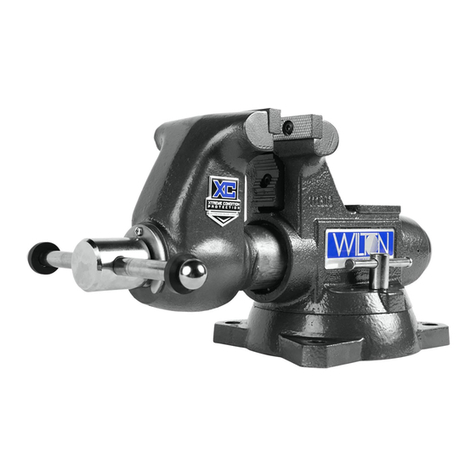
Wilton
Wilton Tradesman Vise 1745XC quick start guide

Yost Vises
Yost Vises 908-HV manual

Mitsubishi Electric
Mitsubishi Electric MELDAS 600 Series instruction manual
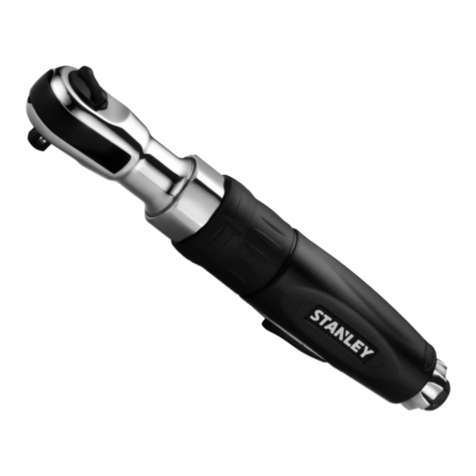
Stanley
Stanley AUTOMATIVE STMT78401-8 quick start guide
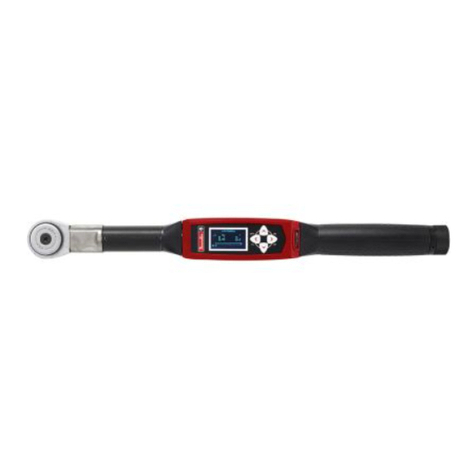
Desoutter
Desoutter Delta Wrench 30 Nm user guide
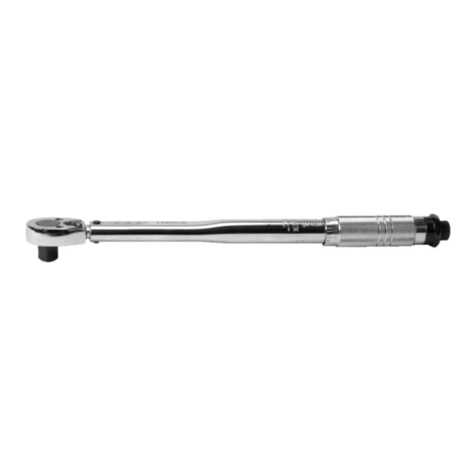
Jula
Jula 149-002 operating instructions
